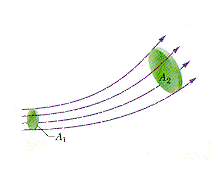In problems involving electric or magnetic fields we visualize the
fields by introducing field lines (often called lines of force),
which have the properties that (1) they are everywhere tangent to the
field vectors, and (2) the density of the field lines is proportional to
the magnitude (strength) of the field. We can use the same method to
visualize the velocity field ![]() by introducing
streamlines,
which have the following properties:
by introducing
streamlines,
which have the following properties:
A streamtube is a tubular region of fluid
surrounded by streamlines. Since streamlines don't intersect, the
same streamlines pass through a streamtube at all points along its length.
Let's take two cross-sections of a streamtube, with cross-sectional
areas ![]() and
and ![]() (see Fig. 2.4).
(see Fig. 2.4).

Figure 2.4: A streamtube in a fluid.
If, in addition, the fluid is incompressible, then ![]() ,
and we have
,
and we have
so that the fluid speed increases when the cross-sectional area of the streamtube decreases. If this seems counter-intuitive, the following analogy might help. You drive down a four lane highway, and due to construction one lane on your side has been closed. The traffic crawls toward the point where the lane has been closed, with cars haphazardly merging into your lane. You finally hit the single lane, and whiz through the construction area. The cross-sectional area has decreased, and your speed has increased.